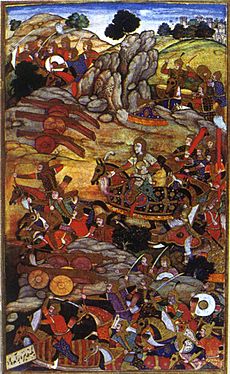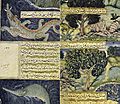Babur facts for kids
Quick facts for kids Babur |
|||||||||
|---|---|---|---|---|---|---|---|---|---|
| Ghazi | |||||||||

Idealized portrait of Babur, early 17th century
|
|||||||||
| Mughal Emperor (Padishah) | |||||||||
| Reign | 20 April 1526 – 26 December 1530 | ||||||||
| Predecessor | Ibrahim Lodhi last sultan of Lodhi dynasty (as Sultan of Delhi) | ||||||||
| Successor | Humayun | ||||||||
| Amir of Kabul | |||||||||
| Reign | 1504–1526 | ||||||||
| Predecessor | Mukin Begh | ||||||||
| Successor | Himself as the Mughal Emperor | ||||||||
| Amir of Ferghana | |||||||||
| Reign | 1494–1497 | ||||||||
| Predecessor | Umar Sheikh Mirza | ||||||||
| Born | 14 February 1483 Andijan, Timurid Empire |
||||||||
| Died | 26 December 1530 (aged 47) Agra, Mughal Empire |
||||||||
| Burial | Gardens of Babur, Kabul, Afghanistan | ||||||||
| Consort |
Maham Begum
(m. 1506) |
||||||||
| Wives more... |
|
||||||||
| Issue more... |
|
||||||||
|
|||||||||
| House | House of Babur | ||||||||
| Dynasty | Timurid Dynasty | ||||||||
| Father | Umar Shaikh Mirza II | ||||||||
| Mother | Qutlugh Nigar Khanum | ||||||||
| Religion | Sunni Islam | ||||||||
Babur (born Zahīr ud-Dīn Muhammad; 14 February 1483 – 26 December 1530) was a brave leader and the founder of the Mughal Empire in the Indian subcontinent. He was a descendant of two famous conquerors: Timur (on his father's side) and Genghis Khan (on his mother's side). People also called him Firdaws Makani, which means 'Dwelling in Paradise'.
Babur was born in Andijan, a city in the Fergana Valley (which is now in Uzbekistan). His father, Umar Sheikh Mirza, was the governor of Fergana. When Babur was just twelve years old, his father died, and he became the ruler of Fergana in 1494. This was a challenging time, as he faced many rebellions and lost his kingdom several times.
Contents
Babur's Early Adventures
Babur's life was full of ups and downs, especially in his early years. He faced many challenges as a young ruler.
Becoming Ruler of Fergana
In 1494, when Babur was only eleven, his father passed away. Babur then became the ruler of Fergana. But his uncles and some nobles tried to take his throne. Luckily, his grandmother, Aisan Daulat Begum, helped him keep his position.
Many nearby kingdoms were ruled by his relatives, who were always fighting. Babur dreamed of capturing the city of Samarkand.
Losing and Gaining Kingdoms
In 1497, Babur successfully captured Samarkand after a seven-month siege. He was only fifteen years old, and this was a huge achievement for him. However, while he was away, a rebellion back home caused him to lose Fergana. When he tried to get Fergana back, he lost Samarkand too. He had held Samarkand for only 100 days. He considered this loss one of his biggest defeats.
For three years, Babur focused on building a strong army. In 1501, he tried to take Samarkand again but was defeated by Muhammad Shaybani Khan, a powerful Uzbek leader. Babur even had to give his sister, Khanzada, in marriage to Shaybani as part of a peace deal. After this, Babur lost hope of getting Fergana back. He was left with nothing and had to look for new opportunities.
Conquering Kabul
In 1504, Babur crossed the snowy Hindu Kush mountains. He managed to capture Kabul from its ruler, who was a child. This gave him a new kingdom and helped him regain his wealth. He ruled Kabul until 1526.
In 1505, Babur began his first trip towards India. He wrote in his memoirs, "My desire for Hindustan had been constant." He made a short raid across the Khyber Pass.
Babur later formed a partnership with Ismail I, the Shah of Persia. Together, they tried to take back parts of Central Asia. Babur managed to capture Samarkand for the third time, but he lost it again to the Uzbeks. After three years, he returned to Kabul in 1514. The next 11 years were mostly peaceful, and Babur used this time to improve and train his army.
Building the Mughal Empire
Babur still wanted to escape the Uzbeks. He decided that India would be a better place for him than other regions. He wrote about his strong desire to conquer North India.
Moving Towards India
In 1519, Babur reached the Chenab River (in present-day Pakistan). His goal was to expand his rule into Punjab, following the path of his ancestor Timur. At this time, parts of North India were ruled by Ibrahim Lodi, the Sultan of Delhi. But the Delhi Sultanate was weak, and many people were leaving it.
Babur received invitations from Daulat Khan Lodi, the Governor of Punjab, and Ala-ud-Din, Ibrahim's uncle. They wanted Babur to help them against Ibrahim. Babur sent a messenger to Ibrahim, saying he was the rightful heir to the throne. But Ibrahim's forces held the messenger captive for months.
In 1524, Babur marched to Lahore. He found that Daulat Khan Lodi had been driven out by Ibrahim Lodi's army. Babur burned Lahore for two days. He then marched to Dibalpur and put Alam Khan, another rebel uncle of Lodi, in charge. But Alam Khan was quickly defeated. Babur realized he would have to fight Ibrahim Lodi directly.
The First Battle of Panipat

In November 1525, Babur learned that Daulat Khan Lodi had changed sides again. Babur marched to Lahore, and Daulat's army simply disappeared. Daulat surrendered and was forgiven. Within three weeks of crossing the Indus River, Babur controlled Punjab.
Babur continued his march towards Delhi. On 20 April 1526, he reached Panipat. There, he faced Ibrahim Lodi's much larger army of about 100,000 soldiers and 100 elephants. The battle began the next day. Babur used a clever tactic called Tulugma. This involved surrounding Ibrahim Lodi's army and forcing them to face his cannons directly. The loud cannons also scared the war elephants. Ibrahim Lodi died in the battle, which ended the Lodi dynasty.
After this victory, Babur took control of Delhi and Agra. This laid the groundwork for the powerful Mughal Empire in India. However, he still had to defeat other strong leaders, like Rana Sanga.
The Battle of Khanwa

The Battle of Khanwa took place on 16 March 1527, between Babur and Rana Sanga, the Rajput ruler of Mewar. Rana Sanga wanted to remove Babur from India and expand his own Rajput territories. He was also supported by Afghan chiefs who felt Babur had broken promises.
Babur took a defensive position at Khanwa (in Rajasthan) and planned a counterattack. Babur won the battle because of his excellent leadership and modern tactics. This battle was one of the first in India where cannons and muskets were used. Rana Sanga also faced betrayal when one of his allies, Silhadi, joined Babur's army.
Babur respected Rana Sanga's leadership skills, calling him one of the greatest non-Muslim Indian kings of his time.
The Battle of Chanderi
The Battle of Chanderi happened the year after Khanwa. Babur heard that Rana Sanga was preparing to fight him again. So, Babur decided to weaken Rana Sanga by defeating one of his strongest allies, Medini Rai, the ruler of Malwa.
On 20 January 1528, Babur reached Chanderi. He offered Medini Rai another territory in exchange for Chanderi, hoping for peace. But Medini Rai refused. Babur's army then captured the outer fortress at night and the main fort the next morning. Babur was surprised at how quickly the fort fell.
Babur's Personal Life and Interests
Babur was not just a warrior; he also had a deep love for literature, art, music, and gardening.
His Family
Babur married several times. His first wife was Aisha Sultan Begum, his cousin. They had a daughter, Fakhr-un-Nissa, who died young. Later, he married Maham Begum, who was his favorite wife. They had four children, but only one survived to adulthood: his eldest son and heir, Humayun.
Babur also had other wives, including Gulrukh Begum and Dildar Begum. Gulrukh was the mother of his sons Kamran Mirza and Askari Mirza. Dildar Begum was the mother of his youngest son, Hindal Mirza, and his daughter Gulbadan Begum.
A Love for Books and Gardens
During his time in Kabul, when things were more peaceful, Babur spent time on his hobbies. He loved literature and always carried his library with him. He also looked for books in new lands he conquered. He enjoyed art, music, and especially gardening. He created beautiful gardens wherever he went.
Babur's Writings and Legacy
Babur was a talented writer. He left behind a rich collection of literary and scientific works.
The Baburnama
His most famous work is the Baburnama, which is a collection of his memoirs. He wrote it in Chaghatai Turkic, his mother tongue. Later, during the rule of his grandson Akbar, it was translated into Persian, which was the main language of the Mughal court. The Baburnama gives us many details about his life and times.
Babur also wrote beautiful poems called ghazals. He wrote about Muslim law and poetry, and even created his own style of calligraphy called khatt-i Baburi.
A National Hero
Babur died in Agra at the age of 47, on 26 December 1530. His eldest son, Humayun, became the next emperor. Babur was first buried in Agra, but his remains were later moved to Bagh-e Babur in Kabul, Afghanistan, as he wished.
Babur is considered a national hero in Uzbekistan and Kyrgyzstan. Many of his poems have become popular folk songs in Uzbekistan. In 2008, Uzbekistan even issued stamps to celebrate his 525th birthday. Pakistan also named a cruise missile, the Babur Cruise Missile, in his honor.
His autobiography, the Baburnama, is one of the most important things he left behind. It gives us a lively and detailed look into his life and the world he lived in.
Images for kids
-
Coin minted by Babur during his time as ruler of Kabul. Dated 1507/8
-
The meeting between Babur and Sultan Ali Mirza near Samarkand
-
Babur crossing the Indus River
-
Illustrations in the Baburnama regarding the fauna of India
See also
 In Spanish: Babur para niños
In Spanish: Babur para niños








